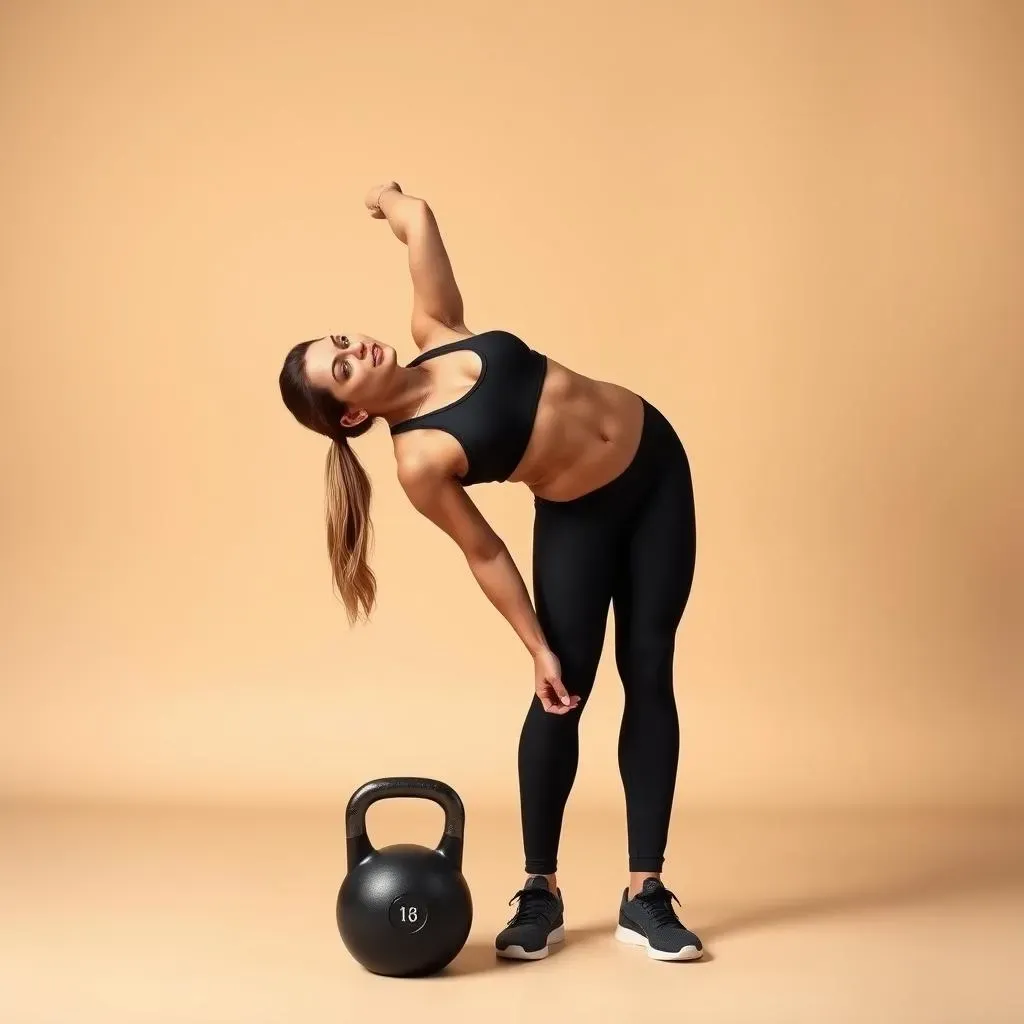Table of Contents
Ready to sculpt those elusive side abs? Forget boring crunches – we're diving into the dynamic world of the kettlebell side ab workout! This comprehensive guide will take you from beginner to advanced, providing everything you need to build strong, defined obliques. We'll explore a range of effective kettlebell exercises specifically targeting your side abs, teaching you the proper form and variations to maximize results and minimize injury risk. Learn how to craft a personalized kettlebell side ab workout routine that fits your fitness level and goals. We'll also cover common mistakes to avoid, ensuring you're on the path to success. Finally, we’ll challenge experienced athletes with advanced variations to keep your workouts exciting and effective. Get ready to transform your core with this powerful and versatile kettlebell side ab workout.
Mastering Kettlebell Side Ab Exercises: Techniques and Variations

Mastering Kettlebell Side Ab Exercises: Techniques and Variations
Kettlebell Side Bend
The kettlebell side bend is a fantastic starting point. Imagine you're gently leaning into a strong breeze. Hold a kettlebell in one hand, feet shoulder-width apart, core braced. Keeping your back straight (this is crucial!), slowly bend at the waist to the side, feeling the stretch in your obliques. Don't let your hips twist; keep them square. Pause at the bottom, then return to the starting position with control. Repeat for the desired reps, then switch sides. Remember, slow and controlled movements are key here; it's about quality over quantity.
A common mistake is hunching the shoulders or arching the back. Focus on maintaining a neutral spine and engaging your core throughout the movement. Think about squeezing your abs as you return to the upright position. This will enhance the effectiveness of the exercise and minimize the risk of injury. Start with lighter weights to perfect your form before increasing the challenge.
Reps | Sets | Rest (seconds) |
|---|---|---|
10-12 | 3 | 30 |
Russian Twists
Russian twists are another classic. Sit on the floor with knees bent and feet slightly lifted. Hold a kettlebell close to your chest. Keeping your back straight, twist your torso to one side, touching the kettlebell to the floor (or as close as you can comfortably reach). Then, twist to the other side. This is a dynamic movement that really works the obliques. Try to maintain a controlled pace, focusing on the controlled rotation rather than the speed of the movement.
To make it more challenging, you can elevate your feet. This increases the range of motion and intensifies the workout. You can also increase the weight of the kettlebell gradually as you get stronger, but always prioritize proper form over weight. Remember to breathe deeply throughout the exercise; exhaling as you twist helps to engage your core more effectively.
- Maintain a straight back
- Controlled twists, no momentum
- Engage core throughout
Creating Your Perfect Kettlebell Side Ab Workout Routine: A StepbyStep Guide

Creating Your Perfect Kettlebell Side Ab Workout Routine: A StepbyStep Guide
Choosing Your Exercises
Building a killer kettlebell side ab workout isn't rocket science, but it does require a bit of planning. First, think about your current fitness level. Are you a complete beginner, or do you already have some experience with core work? Beginners should focus on mastering the fundamental movements like kettlebell side bends and Russian twists, ensuring perfect form before increasing the intensity. More experienced individuals can incorporate more challenging variations and add in advanced moves like windmills or Turkish get-ups. Remember, quality always trumps quantity; it's better to do a few reps with perfect form than many with sloppy technique.
Once you've selected your exercises, think about how many sets and reps you'll do for each. A good starting point is 3 sets of 10-12 reps for each exercise. You can adjust these numbers based on your fitness level and how you feel during your workout. Remember to listen to your body and don't push yourself too hard, especially when starting. Remember to rest for 30-60 seconds between sets to allow your muscles to recover and prevent fatigue.
Exercise | Sets | Reps | Rest (seconds) |
|---|---|---|---|
Kettlebell Side Bend | 3 | 10-12 per side | 30 |
Russian Twists | 3 | 15-20 per side | 30 |
Structuring Your Workout
Now that you've chosen your exercises, it's time to structure your workout. A good approach is to start with a dynamic warm-up, such as light cardio and some dynamic stretches to prepare your muscles for the workout. Then, you can perform your chosen kettlebell side ab exercises in a circuit, performing one set of each exercise before resting. This approach keeps your heart rate up and maximizes calorie burn. After completing all exercises, consider adding a cool-down period of static stretching to help your muscles recover and improve flexibility.
The frequency of your workouts depends on your fitness goals and recovery ability. Aim for 2-3 workouts per week, allowing at least one day of rest between sessions. This allows your muscles time to recover and rebuild, preventing overtraining and promoting muscle growth. Remember that consistency is key; it's better to have regular, shorter workouts than infrequent, overly intense ones. Listen to your body; if you're feeling excessively sore or fatigued, don't hesitate to take an extra rest day.
- Warm-up (5-10 minutes)
- Workout (20-30 minutes)
- Cool-down (5-10 minutes)
Progressive Overload: The Key to Results
To continuously challenge your muscles and see results, you need to progressively overload your workouts. This means gradually increasing the difficulty of your workouts over time. This can be done by increasing the weight of your kettlebell, the number of sets and reps, or by adding more challenging variations of the exercises. Another effective method is to reduce the rest time between sets, increasing the intensity of your workout. Remember to always prioritize proper form over increasing the weight or intensity too quickly.
Don't be afraid to experiment and find what works best for you. Keep a training journal to track your progress and make adjustments as needed. Remember, consistency and progressive overload are the keys to unlocking a strong, defined core. As you get stronger, you'll notice your workouts becoming easier, and that's when you know it’s time to increase the challenge. Listen to your body, and celebrate your progress along the way!
Avoiding Common Mistakes in Your Kettlebell Side Ab Workout

Avoiding Common Mistakes in Your Kettlebell Side Ab Workout
Ignoring Proper Form
Let's be honest, it's tempting to rush through reps, especially when you're feeling the burn. But with kettlebell side ab exercises, proper form is paramount. Think of your body as a finely tuned machine; if you use it incorrectly, you risk injury and won't see the results you desire. A common mistake is rounding your back during side bends or twisting too forcefully during Russian twists. This compromises your spine and reduces the effectiveness of the exercise. Focus on slow, controlled movements. Engage your core throughout the entire range of motion, and keep your spine neutral.
Another frequent error is using momentum instead of controlled muscle contractions. This isn't about speed; it's about feeling the burn in your obliques. Slow down, concentrate on the muscles you're working, and resist the urge to swing the kettlebell using inertia. If you're struggling to maintain proper form, reduce the weight or the number of repetitions. Mastering the technique is more important than lifting heavy weights.
Mistake | Correction |
|---|---|
Rounded back during side bends | Maintain a neutral spine, engage core |
Using momentum during twists | Controlled movements, focus on muscle contraction |
Advanced Kettlebell Side Ab Workouts for Experienced Athletes

Advanced Kettlebell Side Ab Workouts for Experienced Athletes
Kettlebell Windmills
Ready to level up your side ab game? Let's talk kettlebell windmills. This exercise is a true test of core strength, balance, and flexibility. Stand with feet shoulder-width apart, holding a kettlebell in one hand. Extend your other arm overhead, keeping it straight. Slowly bend at the waist, lowering the kettlebell towards the floor as you extend your other arm down towards the ground. Your extended arm and kettlebell should form a straight line. Keep your core tight and your back straight; this prevents injury and maximizes engagement of the obliques. Slowly return to the starting position, maintaining control throughout the movement.
Windmills are challenging, so start with a lighter weight and focus on perfecting your form. As you get stronger, you can increase the weight or incorporate variations, such as adding a leg lift for an extra challenge. Remember to keep your movements controlled and deliberate. Don't rush, and focus on feeling the stretch and contraction in your obliques.
Reps | Sets | Rest (seconds) |
|---|---|---|
5-8 per side | 3 | 60 |
Turkish Get-Ups
The Turkish get-up is a full-body exercise that heavily engages your core, including your obliques. Lie on your back with a kettlebell in one hand, arm extended. Press the kettlebell upward, transitioning to a seated position, then a kneeling position, and finally, standing up. Maintain a straight back throughout the movement, engaging your core to stabilize your body. Slowly reverse the movements to return to the starting position. The Turkish get-up is a fantastic exercise that enhances strength, stability, and coordination.
This dynamic movement requires significant core strength and stability. Start with a lighter kettlebell and focus on perfecting your form. As you progress, increase the weight gradually, ensuring you maintain control throughout the exercise. The Turkish get-up is a complex movement, so take your time and focus on proper technique before attempting heavier weights. This will help you avoid injury and maximize the benefits of the exercise.
- Maintain a neutral spine
- Controlled movements
- Engage core throughout
Renegade Rows with Kettlebells
Renegade rows are a fantastic way to combine strength training with core work. Start in a plank position, holding a kettlebell in each hand. Keeping your core tight and your body in a straight line, row one kettlebell towards your chest, then lower it back down. Repeat on the other side. This exercise is a real core burner, engaging your obliques to stabilize your body while you perform the rows. It’s a full-body exercise that challenges your entire core, shoulders, and back.
To make this even more challenging, try alternating the rows quickly, or add a leg lift at the same time. Remember to maintain a stable plank position throughout. Don’t let your hips sag or your body twist. Focus on controlled movements and maintain proper form. Start with lighter kettlebells until you’ve mastered the technique. As you grow stronger, increase the weight, adding more reps or sets to your workout.